CTIA: Maybe Your RF Safety PR Strategy Isn't Working?
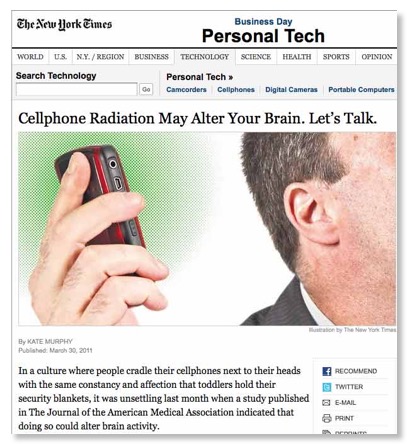
Dear friends in the cellular industry,
While the above NY Times article today is not unprecedented and contains lots of garbles and misinformation, it might be time to think about whether the PR strategy of the cellular industry on RF safety needs review. While the ongoing tragic events in Japan are totally unrelated to the cellular RF safety issue, they may cause growing public distrust in government and industry when they say everything is safe.
The basic view of the cellular industry is that cell phones meet government safety standards and that is all you need to know. Trust the government and trust the cellular industry. That is the mantra. I don’t know what newspapers the leaders of the cellular industry read, but I get the distinct impression that “outside the Beltway” trust in the government is decreasing for a variety of reasons and certain radio/TV personalities and politicians are capitalizing on the trend.
A decade ago the cellular industry fought hard to keep the SAR data for individual cell phone models buried in the the FCC lab’s web site where they were nearly impossible to find. Only forceful action by Chmn. Kennard was able to bring about the current policy where SAR data availability made simple enough for other websites to collect it en masse for posting for the public.
Does SAR data for a given phone give the whole picture of cell phone safety? No. Other factors matter including how one holds the phone and the coverage of the cellular operators (“more bars in more places”). Indeed, the general trend towards smart phones and the decrease in total voice minutes means that the total RF exposure of the US public is probably decreasing since the usual SAR number is based on a handheld cellphone held next to the head for a voice call.

Wikipedia photo
CTIA staff are also not returning calls or e-mails from your blogger - I really don’t try to contact them very often. Perhaps I have been labelled an Ibsen-esque “Enemy of the People” in their hallways - even though I sided with them over NAB on the “FM radio in cell phone” issue.
I have repeatedly contrasted the position of the US industry with that of AFOM (now called La Fédération Française des Télécoms Collége Mobile), CTIA’s French counterpart. Their RF safety website has pragmatic information about RF safety and steps one might take to decrease exposure - not stonewalling about “trust government and industry”. One source in US industry told me that a reason for the current position is to limit liability if a health problem is ever found. If this is true, perhaps industry ought to get a “legal second opinion”.
Again, there is no known reason to believe that the moment that present cell phone use poses any safety problem and indeed total public exposure may be decreasing due to usage trends. But the certainty in this statement is not high enough to justify the industry’s present “stonewalling” posture. There is a reasonable middle ground. Maybe you should consider it.
UPDATE
| MAGAZINE |
On April 14, The New York Times posted a link to the above long article that will appear on Sunday.. The author, Dr. Siddhartha Mukherjee (smukherj2011@gmail.com) is an assistant professor of medicine in the division of medical oncology at Columbia University. He is the author of Emperor of All Maladies: A Biography of Cancer .
It is clear this controversy is not going away. Perhaps in keeping with their San Francisco strategy, CTIA will stop advertising in NYTimes and advise its members to do likewise.
I think better and realistic public engagement on the issue with pragmatic information on how to decrease exposure is a better policy. However, at present CTIA is focusing on its “Freedom is Wireless” campaign to make everyone feel good. Do they have the same PR firm as the American Petroleum Institute that wants you to feel their industry is also “touchy feely”?
Cherry Blossoms Bloom!
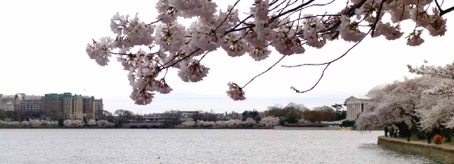
For people outside of Washington, the cherry blossoms are now in bloom. You might not fully realize where the current FCC location is with respect to the cherry blossoms and the Jefferson Memorial.
We took this picture yesterday. The buildings at the left are the Portals complex where the FCC is. The reddish building in front is the Mandarin Oriental Hotel, to the right of it is the main FCC building. To the left of it is another building that has some FCC offices, including the WTB Auctions Division.
Danger FUD Attack!
The Bizarre Case of LightSquared and GPS
The Bizarre Case of LightSquared and GPS
FUD (fud) n. 1. a method of disparaging an opponent by avoiding the specifics of an issue and creating a smoke screen of “fear, uncertainty, and doubt”
The spectrum struggle of LightSquared to obtain permission to use its spectrum for terrestrial broadband use in addition to the mobile satellite use it is already licensed for looks like it will be a classic one at FCC, bringing back elements of previous epic struggles like Northpoint/MVDDS, UWB, AWS-3/M2Z, and PCS H block. These all involved a proposed new spectrum use that threatened incumbent users with possible interference.
To make matters worse, in 3 of the above cases the new entrant would also be competing with the incumbent, a combination sure to infuriate any incumbent with an FCBA directory at hand and the funds to wage a protracted legal battle. The fact that DirecTV was on “the auction block” during the Northpoint/MVDDS battle and T-Mobile was also during the AWS-3 battle meant that those two firms had extra incentive to assuage the fears of potential multibillion dollar buyers by waging a scorched earth policy before FCC. Now we see the GPS industry doing the same with respect to their neighbor LightSquared and NTIA and the military are joining in. The GPS industry is taking advantage of the “ex parte loophole” to lobby IRAC members and NTIA to press FCC off the public record.
(The 12/13/10 USGIC letter to NTIA is in the record of this proceeding only because an OET staffer mysteriously got a copy from NTIA and took the initiative to place it in the file. Had NTIA not sent a copy of the actual letter to the OET staffer, the content of this letter might never have become public. Why doesn’t NTIA reveal this outside lobbying clearly intended to influence FCC? Transparency is a big issue for the Department of Commerce, shouldn’t NTIA be a team player over there? This week Secretary Locke said in Brazil, “we hope the Brazilian government will continue its efforts to build a business climate with more transparency and a more consistent regulatory environment”. Let’s see how well NTIA can do in the transparency area!)

Speaking at the Air Force Association's Air Warfare Symposium in Orlando, Gen William Shelton says the 4G mobile broadband network in the works from LightSquared would spread 40,000 towers - and interference - across the US.
"Within three to five miles on the ground and within 12 miles in the air, GPS is jammed by those towers," Shelton says. "If we allow that system to be fielded and it does indeed jam GPS, think about the impact. We're hopeful we can find a solution, but physics being physics we don't see a solution right now. Where did these numbers come from? A lot of people think he went “hook, line, and sinker” for data from a report from Garmin, not exactly a high end GPS manufacturer. “Physics being physics” - a great sound bite, but does it belong in the policy deliberations here?
In this proceeding as well as the 4 mentioned above, the opponents of progress demonstrated that a poorly designed new system would cause interference to their system and then made the extrapolation that ANY such new system must cause interference no matter how it is designed! To make matters worse, Gen. Shelton and the GPS industry repeatedly use the term “jam”. Google now gets 175,000 hits on the terms “GPS”, “jam” and LightSquared”! Note that a recent joint USGIC/LightSquared joint filing uses the more objective and technically correct term “potential for overload interference/desensitization to GPS receivers, systems, and networks”.
To help spread FUD, several companies and organization have formed a group, Coalition to Save Our GPS (CSOG). In addition to GPS companies Garmin and Trimble, the group includes: the Aeronautical Repair Stations Association, Air Transport Association, Aircraft Owners and Pilots Association (AOPA), American Association of State Highway and Transportation Officials, American Rental Association, Associated Equipment Distributors, Association of Equipment Manufacturers, Case New Holland, Caterpillar Inc., Edison Electric Institute, Esri, General Aviation Manufacturers Association, Deere & Company, National Association of Manufacturers, and OmniSTAR.
Readers may recall that AOPA is the group that has successfully pressured FAA for 20 years not to adopt ICAO ILS receiver standards that prevent receiver-generated intermodulation because they would rather that the whole burden of preventing the problem be on the FM broadcast industry. These ILS receiver standards have been adopted in most other countries but would inconvenience AOPA members who might wish to use 20 year old ILS receivers and feel they have a constitutional right to use anything the FAA ever approved!
Let’s see what the spectrum in question looks like:
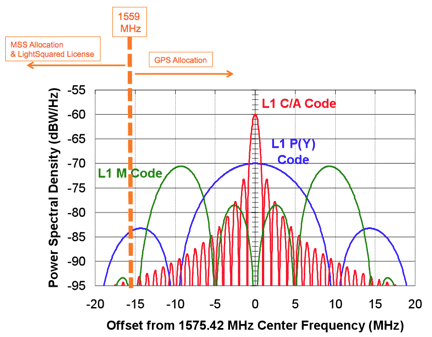
As can be seen, most of the GPS energy is in its allocated spectrum above 1559 MHz but the blue colored L1 P(Y) has some noticeable power below 1559 MHz. While the L1 C/A code is what is received in consumer GPS receivers, the P(Y) signal was intended only for military use and is often encrypted. The latest GPS satellites use the L1M code which stays within the allocation. As an excellent e-book from Trimble points out, “Because this code (P(Y)) modulates both the L1 and L2 carriers, some advanced civilian receivers can play sophisticated games with the two frequencies to help eliminate errors caused by the atmosphere”. Thus the sophisticated real-time kinematic (RTK) receivers with centimeter accuracy use a piece of Government spectrum that was not planned for civilian use; with NTIA-authorized transmitters but receivers that never went through the NTIA spectrum planning process. In addition, L1 consumer grade receivers with marginal filters in their front ends could be subject to overload interference/desensitization from unexpectedly strong adjacent channel signals.
The first problem is related to FCC and NTIA not paying enough attention to the fact that a large nongovernment community was using an NTIA authorized Government system in ways that were not planned. This latter problem is oddly similar to the PCS H block problem and the AWS-3/M2Z problem and deals with reasonable present and long term expectations for receiver filters. Normally in an exclusively government band like GPS’ this would have been decided by NTIA as part of its normal process, but the commercial products did not have to met the receiver specs filed at NTIA by the Air Force. An old saying in the spectrum management business is that “transmitters do not use spectrum, receivers do”. While FCC generally does not regulate receivers, NTIA does but commercial GPS receivers fell in the interagency gap.
As part of their FUD attack, the GPS community is stating conditions (demands?) for any outcome:
Further, the FCC's, and NTIA's, finding that "harmful interference concerns have been resolved" must mean "resolved to the satisfaction of pre-existing GPS providers and users.”
Resolution of interference has to be the obligation of LightSquared, not the extensive GPS user community of millions of citizens. LightSquared must bear the costs of preventing interference of any kind resulting from operations on LightSquared's frequencies. GPS users or providers should not have to bear any of the consequences of LightSquared's actions.
So according to their first point, “public interest” should no be longer the criteria for spectrum policy decisions. 77 years after the passage of the Communications Act we should designate certain spectrum users, in this case not even licensees, with veto power over certain spectrum decisions. I bet the whole NAB membership will be next in line for such veto power or be insulted if they don’t get it first!
In the second point it appears that as in the case of the aging ILS receivers that AOPA and FAA are protecting, any GPS receiver ever sold must be protected for the rest of its natural life. FCC is nearing the end of a 20 year transition of narrowbanding VHF and UHF land mobile spectrum. Would a 20 year transition for upgrading GPS receiver filters be slow enough be acceptable to CSOG? Since AOPA is involved, will they insist that spectrum efficiency wait until the last current model GPS dies a natural death as they have in the ILS case? Would groups like AOPA object to adjacent band signal rejection standards for new GPS units? Would that constitute the dread “bear(ing) any of the consequences of LightSquared decisions”? Are there any compensating public interest benefits of what LightSquared proposes in the eyes of CSOG?
Despite what Gen. Shelton says about “physics”, some of the building blocks of a solution are clear:
• LightSquared could carefully shape the beam and particularly the vertical pattern of their antennas to limit power flux density (pfd) on the ground and in the air. The alarmist Garmin report that Gen. Shelton appears to have based his statements on assumed 32 dBW EIRP for the LightSquared system and did not consider any beam shaping that would limit pfd on the ground or in the air. Thus it ignored all the lessons of the Northpoint/MVDDS controversy.
•The GPS community could switch to higher performance filters in their new receiver front ends. Such a switch is not painless but filter technology, not unlike digital semiconductor technology improves with time and will continue to improve.
•LightSquared could shaped their spectrum and stay away from the GPS lower edge in their initial implementation when they have fewer cell sites and hence need more power. The shape could change as the GPS receiver population improves with time and as increased cell site density decreases base station power requirements.
Meanwhile read for yourself what is happening. For procedural reasons this is not a docketed proceeding, but is on the obscure International Bureau Electronic Filing System (MyIBFS). Here is a direct link. MyIBFS was clearly not intended for this type of “food fight” and may collapse under the weight of the consumer comments CSOG is soliciting- it is already getting difficult to use for this issue. Fortunately MyIBFS is so user unfriendly that individuals probably can’t file directly and CSOG is asking consumers to e-mail a general FCC address which probably will be swamped.
Meanwhile, LightSquared and USGIC are meeting as directed by FCC to try to resolve their differences. FCC and the public get monthly views - on the chaotic MyIBFS site - of what is happening. It is sort of a negotiated rulemaking without the safeguards of the Negotiated Rulemaking Act. Negotiated rulemakings have never worked at FCC, but such 2 sided negotiations have had problems also. In the 1980s FCC told educational FM licensees to solve their power increase differences with adjacent band TV channel 6 licensees (another adjacent band power increase problem!) But the Commission had to fine tune the negotiated agreement, finding that agreements between the directly affected parties do not always reflect the overall public interest.
UPDATE
On March 25 the Deputy Secretaries of DoD and DOT wrote to Chmn. Genachowski on the public record - since unlike NTIA they do not “share jurisdiction” with FCC. They complain that their agencies are not included “in the initial workplan or its key milestones”. They say “we are concerned with this lack of inclusiveness regarding input from federal stakeholders”.
Wow! Given a choice between a seat - or 2 seats in this case - on IRAC or being invited to USGIC/LightSquared powwows I know which I would choose! IRAC members get drafts of FCC decisions that no other outsider sees and generally can make nonnegotiable demands on FCC as a price for coordination. Notwithstanding the fancy language about NTIA’s role, NTIA almost always acts as the IRAC’s messenger/law firm and types the IRAC demands on Commerce Department letterhead for transmission to FCC.
On the other hand, the negotiated rulemaking approach above would avoid DoD and DOT being left out int he cold. But are DoD and DOT willing to stop using the “NTIA loophole” to funnel private firms issues to FCC through NTIA off the public record? Will DoD and DOT commit to full transparency in this proceeding except for valid national security issues?
NEW UPDATE
FCC has now place the comments in docket 11-109 so they are available by way of ECFS. Despite its many quirks, ECFS has much better search facilities than the obscure MyIBFS which clearly was not intended for such large proceedings.
Why Can't FCC Have as Good a Website as the Obscure FERC?

I have written here several times about the endless clutter on the FCC website. The current website design dates to the Hundt chairmanship and may have been cutting edge at the time, but would be an embarrassment to most teenagers in this age of Facebook.
I have even given data, shown at right, that compares the number of words and number of links on FCC’s homepage compared to other agencies. While FCC’s homepage has improved slightly since this data was collected, FCC is still the leader in clutter.
Recently the Federal Energy Regulatory Commission (FERC) revised its website. FERC is the successor of the former Federal Power Commission and was created within the Department of Energy as an independent body. Like FCC it has technical jurisdiction as well as nontechnical and merger jurisdiction over several industries: gas, oil, electricity, hydropower, pipelines, etc. Like FCC it has a complex workflow.
The new FERC design manages to fit this workflow into a neat homepage that efficiently send users where they need to go. It even has room for photos (but not the names) of the 5 FERC commissioners even though no other commission in the federal government other than FCC even names its commissioners on its homepage.
Somebody has to be in charge and have the authority to tell bureau chiefs and commissioners that they can not clutter up the homepage with news of their favorite pet project. A clean, well organized homepage helps everyone quickly find the information they are looking for. It is not enough to have lots of information like the FCC website has, one has to be able to find wanted information quickly.
Other commissions and agencies have this discipline, why can’t FCC?
Sendai, Japan - A Radio Technology Hub
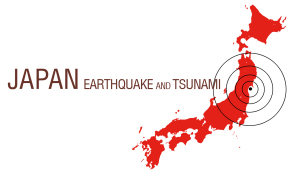
Latest information about the disaster in Japan and
information about ways you can help.
My friend, Emily Murase, points out that the Japanese Cultural and Community Center of Northern California (JCCCNC), a US 501(c)(3) organization, has established a fund to help the victims of the devastating earthquake and tsunami that hit Japan on March 11, 2011 and is accepting online donations.
____________________________________________________________________________________________

I have spoken several times at conferences hosted by RIEC and have fond memories of the staff, their kind hospitality and the excellent facilities. I hope this famous facility and its wonderful staff survived the disaster without serious impact and will continue their pioneering wireless research.
(The SpectrumTalk logo is based on a photo taken in Sendai.)
Yagi-Uda antennas of Tohoku University
Amateur Radio Club and cherry blossoms
April 2009
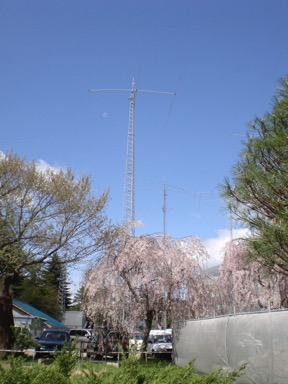
UPDATE
The Tohoku University and RIEC websites are now operational. Hopefully this is a good sign that recovery is proceeding.
"If there is only one action we could take this year to reform the FCC" - What would it be?
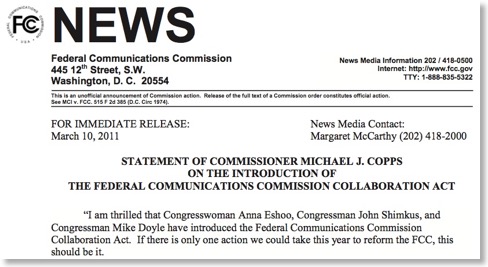
Comm. Copps issue a statement yesterday shown in the above FCC news release. Here is the full text:
“I am thrilled that Congresswoman Anna Eshoo, Congressman John Shimkus, and Congressman Mike Doyle have introduced the Federal Communications Commission Collaboration Act. If there is only one action we could take this year to reform the FCC, this should be it.
“The inability of Commissioners to get together and talk as a group makes zero sense.The statutory bar on more than two Commissioners talking together outside a public meeting has had pernicious and unintended consequences—stifling collaborative discussions among colleagues, delaying timely decision-making, discouraging collegiality and short-changing consumers and the public interest. For almost a decade I have seen first-hand and up closethe heavy costs of this prohibition.
“Elected representatives, cabinet officials, judges and just about everyone else have the opportunity for face-to-face discussion before deciding public issues. I see no reason why Commissioners of the FCC should not have the same opportunity at their disposal—especially when balanced, as this legislation is, with specific safeguards designed to preserve transparency. Reaching agreement on the complex issues pending before us is difficult enough in the best of circumstances, but is infinitely more so when we cannot even talk about them among ourselves. Each of the five Commissioners brings to the FCC special experiences and unique talents that we cannot fully leverage without communicating directly with each other.
“The Federal Communications Commission Collaboration Act is a prudent, balanced proposal that recognizes the benefits of permitting the Commission to do its business collectively while maintaining full transparency of the process. This is a reform whose time has come. Ithank the Representatives for their leadership on this much needed reform and wish them successin seeing it through to enactment this year.”
What this bill, H.R. 1009, proposes is a major change to the Carter-era Government in the Sunshine Act, 5 USC 552b. The present law applies not just to FCC, but to the plethora of commissions throughout the federal government from the American Battle Monuments Commission to the Securities and Exchange Commission. But this pending bill only applies to FCC.
The commissioners are allowed to meet in closed meetings for certain subjects under the terms of 5 USC 552b(c). Allowed subjects include personnel matters, ITU conference preparation, and “internal personnel rules and practices of an agency”. While such meetings were infrequent but recurring when I joined FCC in 1979, I do not recall any in the past 2 decades.
FCC and other regulatory commissions are required to meet at least once a month. For more than a decade FCC has just met this minimum requirement. By contrast SEC meets twice a month and NRC meets 3 times a month.
My question for readers, if there was only one reform for FCC this year, would this be your highest priority? Note that you can post to this blog anonymously if you wish and no one, including your blogger, will know who you are.
CORRECTION
A more thorough search of the FCC website showed that there was one closed meeting in 2000 and one in 2001. The FCC site is usually reliable as far back as 1995, so this would imply 2 closed meeting in the past 16 years.
New National Research Council Report on Spectrum Technology and Policy

With funding from the National Science Foundation, the National Academy of Sciences/National Research Council today published a report entitled “Wireless Technology Prospects and Policy Options” which” describes key wireless technology trends, their implications, and options for facilitating the introduction of enhanced and new services.” The mission of the NRC is to improve government decision making and public policy, increase public education and understanding, and promote the acquisition and dissemination of knowledge in matters involving science, engineering, technology, and health. Other technical regulatory agencies routinely ask NRC for views on key policy issues - FCC has not in more than 30 years!
The report as a whole will take some digesting I note with interest the following recommendation:
Ensure That Regulators Have Access to Technology Expertise Needed to Address Highly Technical Issues
As this report argues, spectrum policy is entering an era in which technical issues are likely to arise on a sustained basis as technologies, applications, and services continue to evolve. The committee believes that the Federal Communications Commission (FCC) would therefore benefit from enhancing its technology assessment and engineering capabilities and suggests several ways to gain such expertise:
• Make it a priority to recruit topcaliber engineers/scientists to work at the FCC, perhaps for limited terms.
• Use an external advisory committee to provide the FCC with out side, highlevel views of key technical issues. (Indeed, in the past, the FCC convened the Technology Advisory Council to play just such a role.)
• Add technical experts to the staff of each commissioner.
• Tap outside technical expertise, including expertise elsewhere in the federal government such as at the Department of Commerce’s Institute for Telecommunication Sciences and the National Institute of Standards and Technology (NIST), or through a federally funded research and development center.
Readers may recall that this is similar in several ways to IEEE-USA letters to FCC that have been discussed here.
Of course I find it odd that they feel FCC needs more expertise but make no statement at all about NTIA in this area. More later about this important report after some time for review.
Broadcasters and the Spectrum Wars
It's an uphill fight for broadcasters trying to stall or mitigate the FCC's plan to reclaim a large hunk of broadcast spectrum and repurpose it for wireless broadband. The plan enjoys the backing of some of the biggest names in wireless, consumer electronics and the high-tech world, not to mention the White House and fiscal conservatives on the Hill.
The article goes on to say
The lobbying push was organized by the NAB as part of its annual, two-day State Leadership Conference, essentially a legislative rally.
It’s badly needed. In the battle over broadcast spectrum, broadcasters are facing a formidable phalanx of telecommunications, consumer electronics and high-tech companies and their powerful Washington lobbies. Included are some of the biggest names in American industry today: AT&T, Verizon, Sprint Nextel, T-Mobile, Google, Intel, Cisco Systems and Microsoft.
John Eggerton in the real Broadcasting & Cable chimes in with a piece entitled “Sparring Over Spectrum” which ends with
“Broadcasters are facing a tough battle for their frequencies in the face of the broadband deployment push, which recently got a shove from the White House’s National Wireless Plan. While the FCC has been pushing for incentive auction authority to compensate the broadcasters who give up spectrum, it has not yet gotten it. The FCC could mandate the move without payment, but broadcasters would fight that with everything they’ve got.”
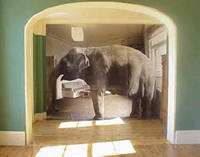
If the mobile parts of NBP are successful we will also have widespread mobile broadband to satisfy the video needs of boaters and campers. In the UK, broadcasters, e.g. US citizen Rupert Murdoch, do not own any spectrum, they provide digitized programming with advertising to 3rd party Arqiva which multiplexes them together on DTV transmitters for public use. Is that so bad?
FCC Enforcement in Action: The Mysterious AT&T San Juan Case
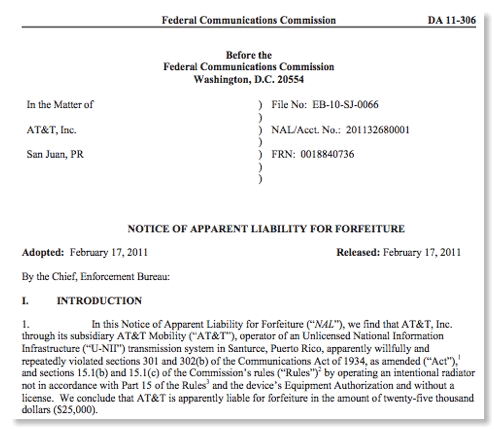 The issue of FCC equipment marketing enforcement has been a recurring issue here. Mitchell Lazarus, writing recently in FHH CommLawBlog pointed out the strange case of a recent Notice of Apparent Liability dealing with alleged AT&T use of 5605 MHz in San Juan PR. The NAL states
The issue of FCC equipment marketing enforcement has been a recurring issue here. Mitchell Lazarus, writing recently in FHH CommLawBlog pointed out the strange case of a recent Notice of Apparent Liability dealing with alleged AT&T use of 5605 MHz in San Juan PR. The NAL statesAs part of its ongoing coordination efforts with the Federal Aviation Administration (“FAA”), the Enforcement Bureau received a complaint that radio emissions were causing interference on or adjacent to the frequency 5610 MHz to the FAA’s Terminal Doppler Weather Radar (“TDWR”) installation serving the San Juan International Airport. ... On December 7, 2010, agents from the Enforcement Bureau’s San Juan Office (“San Juan Office”) conducted an investigation on the roof of the Miramar Plaza Condominium Building in Santurce, Puerto Rico. The agents from the San Juan Office confirmed by direction-finding techniques that radio emissions on frequency 5605 MHz were emanating from the building’s roof, the location of one of AT&T’s U-NII transmitters, a Motorola Canopy. The Canopy model is certified for use as a Part 15 intentional radiator only in the 5735.0 - 5840.0 MHz band and is not certified as a U-NII intentional radiator.
In his blog post, Mr. Lazarus comments
In cases where a transmitter fails to match its certification, as here, the FCC usually cites the manufacturer. Going after AT&T makes sense only if the FCC thinks the transmitter was compliant when shipped, and that AT&T took it out of the box, re-tuned it to an unauthorized frequency, and turned off the DFS. That would indeed be a blatant offense. But the FCC does not accuse AT&T of doing this. The farthest it goes is to say AT&T “consciously” operated at the unauthorized frequency.

The original software defined radio (SDR) rules adopted in Docket 00-47 in September 2001 had the following requirement:
2.932(e) Manufacturers must take steps to ensure that only software that has been approved with a software defined radio can be loaded into such a radio. The software must not allow the user to operate the transmitter with frequencies, output power, modulation types or other parameters outside of those that were approved. Manufacturers may use authentication codes or any other means to meet these requirements, and must describe the methods in their application for equipment authorization.
In comments filed in Docket 03-108 this rule was challenged by several parties. The R&O states:
Motorola Canopy model #5700A number of parties support a requirement for devices to comply with the rules for software defined radios if the software and operating parameters can be easily changed post- manufacture and/or that pose a high risk of causing interference to licensed services such as public safety.
Intel states that those devices that use software defined radio as a manufacturing technique and are not intended to be modified in the field should not be required to be declared as software defined radios, and that the Commission should impose requirements on only those devices where the manufacturer intends to allow modifications in the field. Vanu, Inc., a manufacturer of software defined radios, believes that mandatory certification as software defined radios may be desirable when harmful interference may result from a foreseeable modification to the device’s software by a third party. It states that the Commission could adopt security requirements that are not limited to radios that meet the definition of software defined radios. The National Public Safety Telecommunications Council and the SDR Forum believe that the Commission’s concern should not be that a radio could be reprogrammed on an individual basis because the number of radios potentially affected that way would not be significant.

So there are several possible explanations of what happened in the San Juan case:
- an unintentional manufacturing error in software or hardware left the Canopy unit capable of operating at 5605 MHz. (Use of this frequency is only permitted if the unit has dynamic frequency selection capability to avoid radar systems. This Canopy unit does not have that capability.)
- Motorola violated its equipment authorization grant and intentionally shipped a unit capable of operating on 5605 MHz
- AT&T or a contractor modified the the software in the Canopy unit to change the frequency out of the authorized band.
So while I don’t have a lot of sympathy for AT&T in this case, it would appear that either Motorola is at fault in its sale of the Canopy unit, in which case its dealers would also be culpable or this case highlights an error in the logic used by the Commission in 2005 for watering down the former 2.932(e) requirement into the present much weaker 2.944 requirement.
It is ironic that when I spoke to the SDR Forum on a panel last year (just prior to the group changing its name to Wireless Innovation Forum) someone asked the panel if the FCC SDR security rules were too weak. I think they are and are the most likely root cause of this incident, but that is what the SDR Forum and others myopically asked for in Docket 03-108 and the FCC complied, ignoring concerns stated by Cingular/Bellsouth at the time.
Let’s hope FCC gives us a full explanation of what really happened in San Juan so we can avoid similar events in this and other bands.
While we are at it, it would also be useful for FCC and NTIA to publicly state why TDWR interference is a recurring problem given that NTIA was able to dictate the terms of the U-NII rules for the shared band. I suspect that DoD dominated the IRAC discussions of the issue and FAA naively assumed that DoD would watch out for all federal radars, not just military units, so did not realize until it was too late that TDWR was different than the military units in some key aspects.
The 1995 Federal Shutdown:
A Belated Confession
Photo by PinkMoose, via Flickr

But your blogger sometimes listens to a different drummer. At that time FCC/OET was in a separate building, 2020 M St. that was almost all private tenants and had no FCC security officer. Since no one bothered to change the lock, it was easy to get in if you had a key. I had a health club membership in the same block and came in 2-3 times/week to work out at the health club. (My wife’s agency had an appropriation at that point, so she had to work anyway.)
After working out at the health club, I sneaked into the FCC/OET office space to both ponder the stupidity of the shutdown and also to water everyone’s plants. I figured that people were stressed out enough about the shutdown - it was not clear at that point whether they would eventually get paid - and the last thing they needed was to come back and find that their beloved office plant of x years had died during the shutdown.
Yes, I violated FCC directions and possibly the law. I hope that the statute of limitations has expired. I have no regrets.
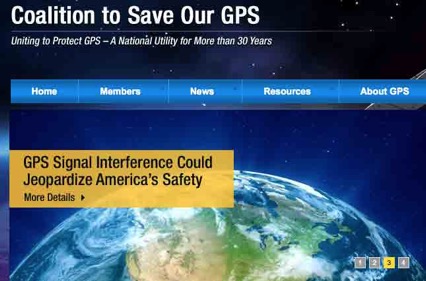
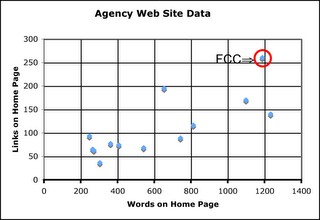



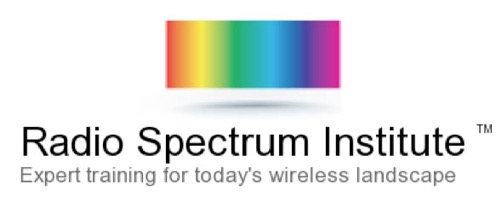


![Validate my RSS feed [Valid RSS]](valid-rss-rogers.png)

